12th November 2025
14 gamers joined us for this weeks games session at the Corn Exchange filling 4 tables with consecutive games.
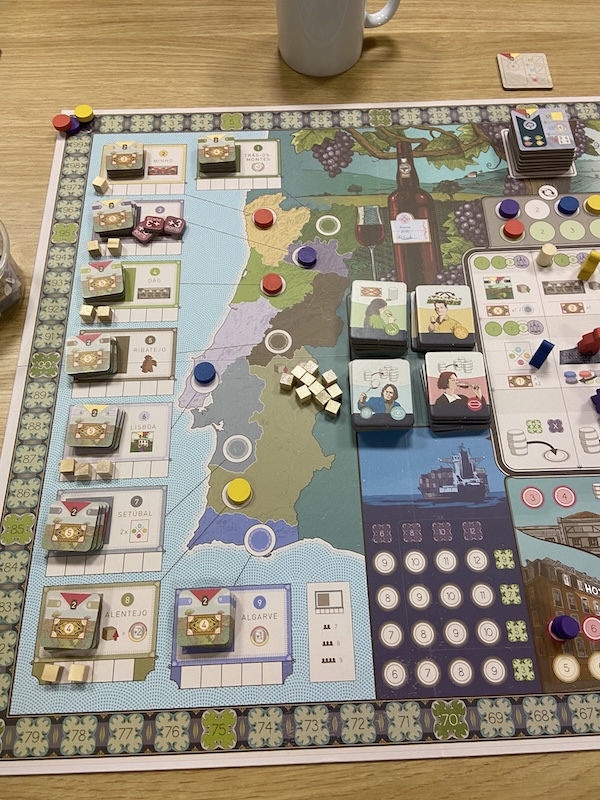
Vinhos had, after several failed attempts, managed to make it to the table at Midcon a couple of weeks previously, and so came out again in an effort to consolidate the ‘learnings’ of the initial game. This is a game about producing wine in the various regions of Portugal, leaning towards the business side of viticulture. Players can have up to 4 estates on their board, each relating to either a red or white wine from one of the 9 regions, with each region having a bonus or condition affecting it. An estate has three spaces for vineyards (up to 2) and wineries (up to 2), each increasing the quality of the wine, with a winery allowing the hire of a wine expert to further increase the quality of your wine – at a cost of course, good help doesn’t come for free.
The game takes place over the course of 6 years, with each year consisting of 2 action phases (do things!), a maintenance phase (pay things! Earn things!) and a production phase (make things!). The 9 action spaces are in a 3x3 grid, and moving your solitary worker token 1 space is free, a second space costs, and it also costs if there is someone else there, as well as if the round tracker is there – the grid also includes the game timer. At the end of years 3, 5 and 6 a wine fair is held, where you present your finest wine and impress the wine magnates, or not.
There are opportunities to sell your wine to various local establishments, or even export to far off climes. Money is tight, with most money going into your bank account, which takes an action to withdraw, but could earn you interest – or indeed, charge you interest, if you’ve been taking a bit too much out. Most in game actions are paid from your hand, so there’s a bit of balancing between your account and your cash.
This is all relevant to the 2010 Reserve version of the game, the deluxe box also contains the 2016 Special Vintage, which is a simplified version, without having to worry about banks or some other stuff – but where’s the fun in that?
Iain, Steph and Darren had all been part of the previous play, so were hoping to get the gameplay embedded in their heads, whilst Steve joined after watching a video, although we soon discovered he had watched the 2016 version when he didn’t recognise a lot of the board, and so wasn’t quite as up to speed as he’d like. After running through the differences, we were soon merrily working away at producing our finest wines and merrily complaining at the lack of funds. And the lack of cheap spaces. And the cost of everything. And why you went there. And the lack of funds. Money is tight, did that get mentioned already?
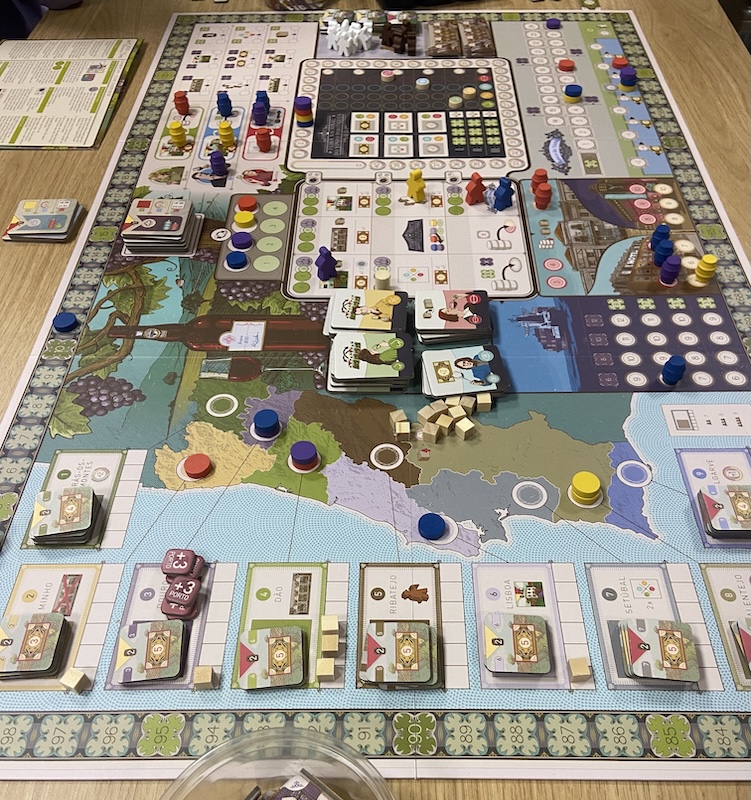
Steve was soon selling his cheap white from Alentejo to the local Fado Houses, using the regions power to boost the quality, and making a better job of selling than Darren with his lovely red port that he’d fortified. Steph and Iain had both purchased wineries to increase the quality of their wine, and in the first few years the weather was good to all, adding a little bonus to the grapes. As the first wine fair approached there was some minor jostling for position – the wine fair having its own section of the board complete with spaces and track and a scoring system that informs the points added to the main score.
As the years passed some subtle whining was coming from Steve’s direction about the lack of cash again, even after pointing out that in the previous game Darren had spent most of the latter stages with no money and no investments, sometimes making pitiful moves where he was able, and sometimes not. There was also a brief discarding of wines as we realised after explaining how to get certain bonus actions we had missed the fact that they came at a cost of discarding wines. The second fair saw Steph take a further lead in the fair scoring, with some aspects of the fair still not seeming to gel with some people.
And with just one year to go until the last fair there was a sudden rush of exports to try and grab some points, with a little area control jostling going on for further end game points. The final year had good weather, so some decent wines were produced, almost impressing the snobs at the fair, and then there was a bit of shuffling barrels around to get end game points.
In the end Steph won with a very fine vintage of 73 points, Iain close behind with a decent 69, Darren in the good house wine section at 63, and Steve trying to decide if his 41 was wine or meths.
There was a convincing pitch for another new game to the club - so four intrepid climbers took on the Leviathan Wilds. With Jeremy leading the group (teaching) role playing as “Edge” a Herald, Neil chose “Cheer” a mycologist Freestyler, James took on “Brick” as a Gadgeteer, and Iker tried “Hazard” as a Breaker. The climbers roam the wilds and locate leviathans that have been afflicted by poisonous crystals and try to help them by destroying the noxious nodules!

This is a cooperative game where you choose a climber and a class which creates a deck of skills. You have a hand of three cards, one is used as the action points for your turn and the others as skills - which can help you or your fellow climbers. Your remaining deck also counts as your grip on the leviathan as you climb, if your deck runs out - you fall!
Using your action points and skills you climb, jump, and glide across the leviathans and locate the crystals to strike them until they are removed, being wary of the ones that can give you blight. All the while the leviathan defends its self due to being under the influence of the toxic crystals that adorn it. The longer you take the more enraged and dangerous the leviathan’s actions become. Each climber has a hit point track that also tracks the blight taken from the crystals and attacks. If these counters converge then the climber is knocked out; the rest of the team then have one move each to complete the task and free the leviathan (succeed) else abandon the attempt (fail).

The first leviathan the group attempted was “Sentinel” a huge armoured bipedal stone giant that took great swings at the climbers as they scaled it, these attacks can sometimes be avoided if you can get out of the way before it strikes at the end of a turn. The three newbies took a while to get into the rhythm of climbing, but were having a good go at clearing the lower crystals. Cheer was happily helping other climbers with extra mushrooms that give random boosts, and Brick was using his gadgets to get up to the higher crystals following in the wake of Edge showing them how its done. Hazard felt picked on and was being targetted by the Leviathan so took a long while just getting up a leg after falling to avoid an attack. Eventually we had only 1 crystal left, but then Cheer took a swift hit to the chest and was knocked out. But Edge managed to strike and clear the last crystal and the leviathan was saved. In this case it just went dormant, and we picked up Cheer and let it be.

Buoyed by our first success, the team decided to try to help another leviathan, though Hazard wanted a respite, so Kestrel the Gambler stepped in (Iker changed character to mix things up). This time we found a sentient wood leviathan called “Hive” that had various swarms of insects living in it that were also affected by the crystal’s malevolence and came to attack us. Kestrel took the lead and fairly zipped up the leviathan with their leap ability. Whilst the others below were being pestered by the swarms, and had to take various moments to rest, heal and get their grip back. Also the leviathan’s attacks were quite good at picking on Edge and though they took out the largest blighted crystal in the centre of the Hive, but had to drop to the ground with Cheer who had lost their grip. We were all pretty beaten up, but Kestrel dodged the swarms to make it to the last crystal, but it was Brick using their hook shot who got there with enough action points to finish it off and free the leviathan. Cheer then took the opportunity to study the creature whilst we distracted the swarms before legging it back home!
An enjoyable cooperative game, with different challenges and a varied level of difficulty using an enragement track and the possibility of mutations!
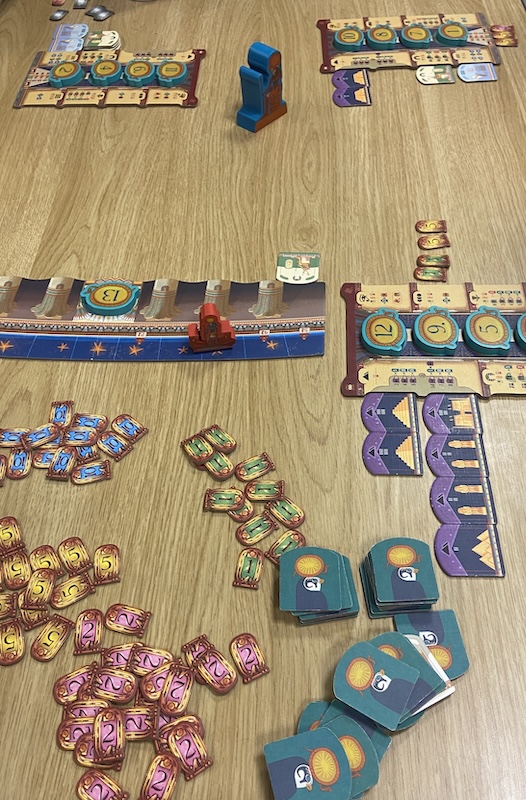
The next table selected Ra making a fourth club play for this egyptian themed auction based game, also recently played in session 113.
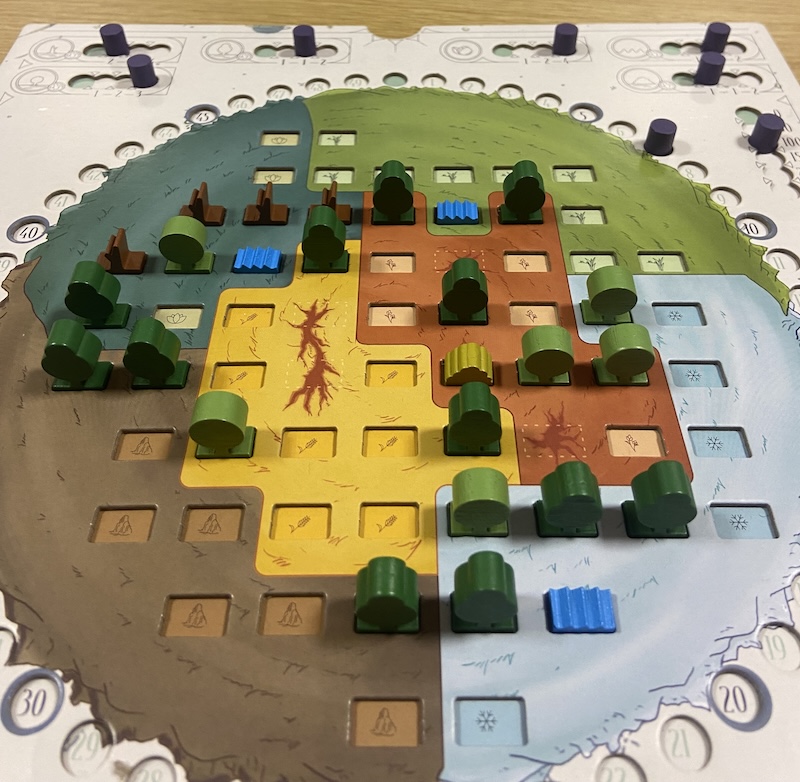
Leaving the final table trying Evergreen. Evergreen has been played once before at the club in session 107. It is played over 4 seasons with 14 rounds total. The aim is to plant seedlings (no points), grow them into small trees, and then large trees. In each round, you compete for cards which allow you to plant / grow trees in certain biomes, and do various extras (plant / grow more trees / plant bushes / make lakes which grow 2 adjacent trees / get points). Points are awarded at the end of each season for light captured by trees not in shadow (small trees 1 point, large trees 2 points) - but large trees cast bigger shadows. Each season the light comes from a different direction, so the shadows change. Points are awarded at the end of each season for the largest forest (number of bushes / small trees / large trees connected). Points at the end of the game are awarded for the number of large trees in each sector, according to scores accumulating through the game. Richie concentrated on getting a large forests and large trees in areas for good end of game scoring, but shadows reduced points for light. Richie did not use bushes or lakes much. Graham used bushes to connect a forest whilst reducing over-shadowing, which proved a winning combination. The game is quick, easy to grasp, and with interesting possibilities.
Both tables finished at the same time so after a bit of a reshuffle the three that knew how to play got stuck into Dune: Imperium, a sixth play at club for this Sci Fi worker placement style game.
And the remaining three players tried some shorter games a few times each, Tsuro and Kingdomino.
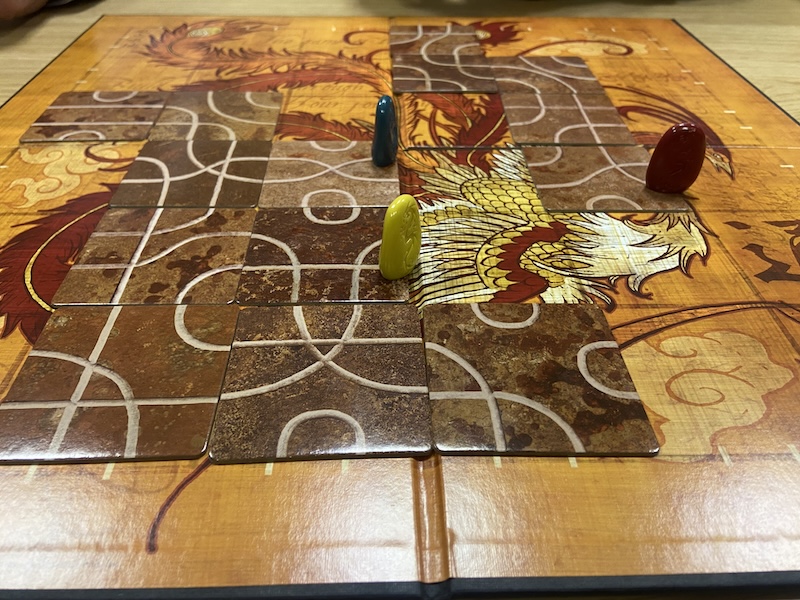
Tsuro (5th club play, but not seen since session 83) is a simple tile laying game, following lines, trying not to get sent off the edge of the board. With 3 players, there was less interaction between players. So it would be more fun with more players. But it was good, with 2 games and different winners.
Then we played Kingdomino, a club favourite with 15 previous plays: on the 1st game, Graham didn’t allow flexibility and had a tile late on that he couldn’t place, putting him last. The 2nd game, had a different winner, which was due to acquiring most of the swamp tiles and being able to place them in one region for a big multiplier.
The next session is the 26th November, the last games session before Christmas break. do join in on Discord if you would like to see what options are being touted for the next session.
There will be a Club Meal at The Welcome Chinese Restaurant on 10th December, if you would like to join us please reserve a space and a £10 deposit is required.
The first session of 2026 will be on January 7th.
- Total Session Attendance: 14
-
Board Games: 7